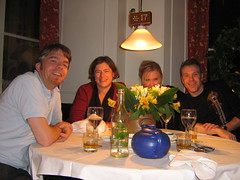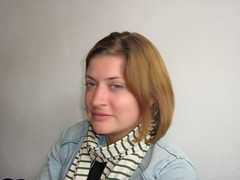Having got through everything I want to say for now about IR9, I hope to finish with my summer interviews–it’s not too long now until I go back to NL for more interviews, so I have to get these done!
So actually one of the earliest interviews I did in the summer was with Brenno de Winter, who I actually first learned of through his podcasts and and website, Laura Speaks Dutch. –That’s a great resource for learning Dutch, by the way. Strangely, he turned out to be the one who had translated the instructions for how to use GPG with Mac mail and when I realized he had done these two totally different but helpful things, emailed to thank him. Once I learned more about his work in IT security and as an IT journalist, I decided to interview him. Also, we’ve gotten to be friends, so it was nice to meet in person finally anyway.
Brenno has a fairly classic history with technology, from the gender standpoint. Like many male geeks, he started very young and was coding before age 10. But beyond that, I’d have to say he violates most other stereotypes about male geeks or hackers. He tends to wear preppy clothes, is quite sociable, has a very positive attitude toward people at all skill levels when it comes to technology, as long as they are trying to educate themselves, and he shows no hostility at all toward girl geeks. In fact he’s very supportive.
Our conversation was not so focused because his work is really outside the new media stuff I usually look at, but we did have a very interesting discussion of what the atmosphere was like in the open source and hacker communities and how it might have changed over time. He felt that when he first got involved, it was very community-spirited, and even described himself as feeling tearful at some evnts, because he was so moved by how everyone cooperated and how warmly people behaved toward each other. Over time though he feels this has diminished and gave the example of his own efforts to found a house in Amsterdam where hackers could live for free. He met with a group of them and offered to help them find funding, which he thought might be fairly easy. But because the group could not reach any agreement at all about how the whole thing might work, it just collapsed and went nowhere.
This really seemed to echo some of how William Uricchio has described his own frustrations in trying to organize new media scholars in the Netherlands for everyones mutual benefit. I wonder if no longer being such small and beleaguered has actually made it harder for people in these groups to unite. This is a fairly common problem when a group that has been outcast starts to gain social currency; since they no longer have to spend all their enrgy and resources to survive, room opens to argue about how to spend the “excess.” Or everyone gains a little power and security, and suddenly they have something to lose, and so they become territorial.
I guess no matter how technology changes, in some ways, people never do.
Anyway, nowadays Brenno is working on a project called Small Sister that aims to educate people about privacy issues and provide tools with which they can guard their privacy in these frightening days of increasing data-retention. It’s already a cool project just in the way it collects together so much useful info about protecting your privacy, but I’m looking forward to seeing what they cook up themselves. He’ll be speaking at 253C in December, so if you are around Berlin, go see him.



